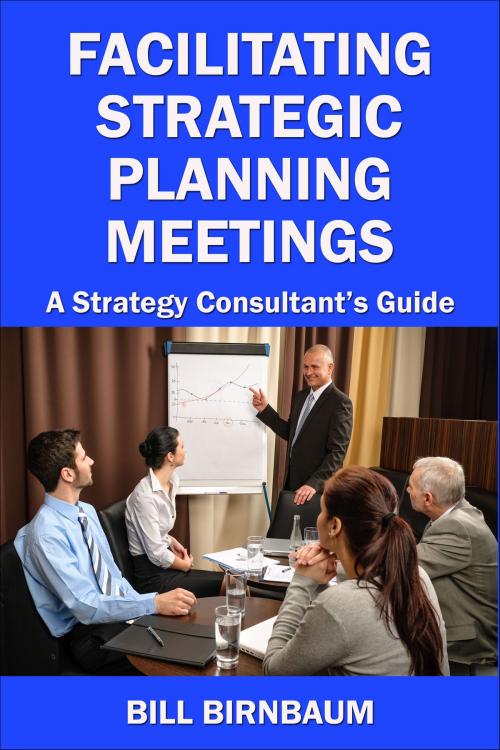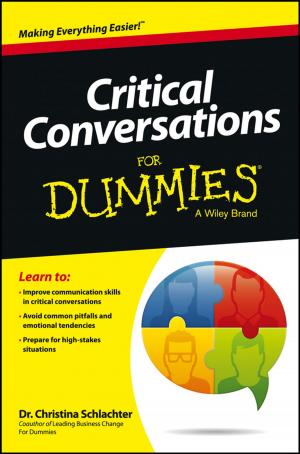Facilitating Strategic Planning Meetings: A Strategy Consultant's Guide
Business & Finance, Management & Leadership, Planning & Forecasting, Business Reference, Business Communication| Author: | Bill Birnbaum | ISBN: | 9781932632040 |
| Publisher: | Bill Birnbaum | Publication: | April 11, 2016 |
| Imprint: | Smashwords Edition | Language: | English |
| Author: | Bill Birnbaum |
| ISBN: | 9781932632040 |
| Publisher: | Bill Birnbaum |
| Publication: | April 11, 2016 |
| Imprint: | Smashwords Edition |
| Language: | English |
The person responsible for facilitating a strategic planning meeting faces a multi-dimensional challenge. Certainly, he or she must keep the planning team on track so that their resultant product is a viable, implementable strategic plan. The facilitator must also assure that a room full of highly opinionated individuals will set aside their day-to-day tasks to focus on their organization’s most critical, long-term issues. And often, the facilitator must guide the planning team’s discussion of critically important, though highly sensitive issues.
This is the challenge which author Bill Birnbaum faced in 1980 when he launched his strategy consulting practice. As there existed no book which would help him navigate this complex challenge, he developed a number of his own methodologies. Since 1980, he has successfully used those methodologies to facilitate strategic planning meetings for hundreds of client organizations. It’s ironic in a way, that a third of a century later, Bill has written the book which he searched for in 1980. Here you have, in some 24,000 words and 20 diagrams, the essence of what Bill has learned in successfully facilitating strategic planning meetings during these last three decades.
From this book, you will learn:
•The one question to ask at the very start of your strategic planning meeting – to initiate lively, strategic-level discussions among your planning team members.
•How to get your strategic planning team to focus on their organization’s key strategic issues and avoid getting bogged down in tactical details.
•The two criteria to use in determining whether or not a suggested internal strength is really an internal strength – so that the strength can later be successfully used to support your strategy.
•How to be sure that a suggested internal weakness is really an internal weakness. For all too often strategic planning teams confuse weaknesses with symptoms of weaknesses. Remember – you can‘t fix a symptom. And before you can fix a weakness, you first have to identify that weakness.
•A valuable tool for consolidating your strategic planning team’s diverse opinions about their organization’s mission statement. In fact, you’ll learn how to facilitate your planning team’s development of their mission statement in three hours or less.
•How to avoid the common mistake of confusing an external opportunity with a strategy.
•How much detail to include in your strategies. For too much detail will present a problem; too little detail will present a worse problem.
•Why and how to challenge your planning team members when they’re setting due dates for their strategies.
•A suggested table of contents of the written strategic plan.
•Options for communicating the resultant strategic plan to others in the organization.
This book serves as a guide for those responsible for facilitating strategic planning meetings. You’ll find it to be equally helpful for both the internal “strategic planning person,” and the external strategy consultant. Whether internal or external, the facilitator faces the multi-dimensional challenge of guiding the organization’s strategic planning team through the process of developing a viable, implementable strategic plan. Bill Birnbaum’s time-tested methodologies will be of help to you.
The person responsible for facilitating a strategic planning meeting faces a multi-dimensional challenge. Certainly, he or she must keep the planning team on track so that their resultant product is a viable, implementable strategic plan. The facilitator must also assure that a room full of highly opinionated individuals will set aside their day-to-day tasks to focus on their organization’s most critical, long-term issues. And often, the facilitator must guide the planning team’s discussion of critically important, though highly sensitive issues.
This is the challenge which author Bill Birnbaum faced in 1980 when he launched his strategy consulting practice. As there existed no book which would help him navigate this complex challenge, he developed a number of his own methodologies. Since 1980, he has successfully used those methodologies to facilitate strategic planning meetings for hundreds of client organizations. It’s ironic in a way, that a third of a century later, Bill has written the book which he searched for in 1980. Here you have, in some 24,000 words and 20 diagrams, the essence of what Bill has learned in successfully facilitating strategic planning meetings during these last three decades.
From this book, you will learn:
•The one question to ask at the very start of your strategic planning meeting – to initiate lively, strategic-level discussions among your planning team members.
•How to get your strategic planning team to focus on their organization’s key strategic issues and avoid getting bogged down in tactical details.
•The two criteria to use in determining whether or not a suggested internal strength is really an internal strength – so that the strength can later be successfully used to support your strategy.
•How to be sure that a suggested internal weakness is really an internal weakness. For all too often strategic planning teams confuse weaknesses with symptoms of weaknesses. Remember – you can‘t fix a symptom. And before you can fix a weakness, you first have to identify that weakness.
•A valuable tool for consolidating your strategic planning team’s diverse opinions about their organization’s mission statement. In fact, you’ll learn how to facilitate your planning team’s development of their mission statement in three hours or less.
•How to avoid the common mistake of confusing an external opportunity with a strategy.
•How much detail to include in your strategies. For too much detail will present a problem; too little detail will present a worse problem.
•Why and how to challenge your planning team members when they’re setting due dates for their strategies.
•A suggested table of contents of the written strategic plan.
•Options for communicating the resultant strategic plan to others in the organization.
This book serves as a guide for those responsible for facilitating strategic planning meetings. You’ll find it to be equally helpful for both the internal “strategic planning person,” and the external strategy consultant. Whether internal or external, the facilitator faces the multi-dimensional challenge of guiding the organization’s strategic planning team through the process of developing a viable, implementable strategic plan. Bill Birnbaum’s time-tested methodologies will be of help to you.















